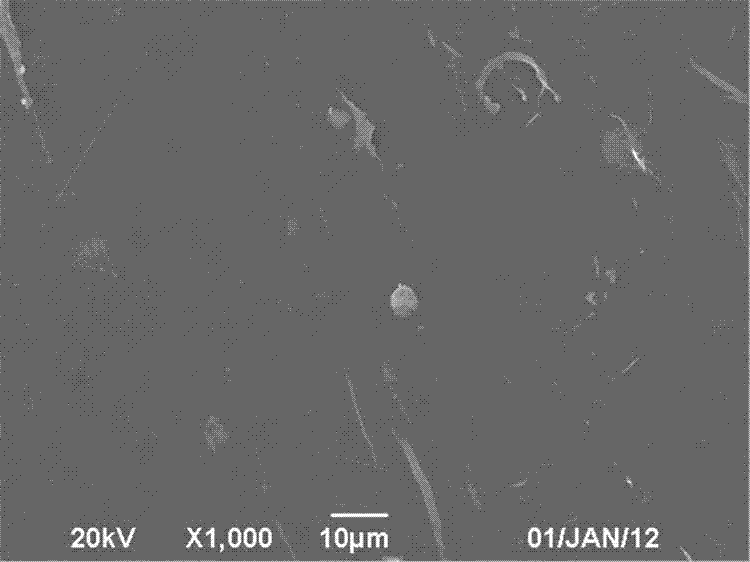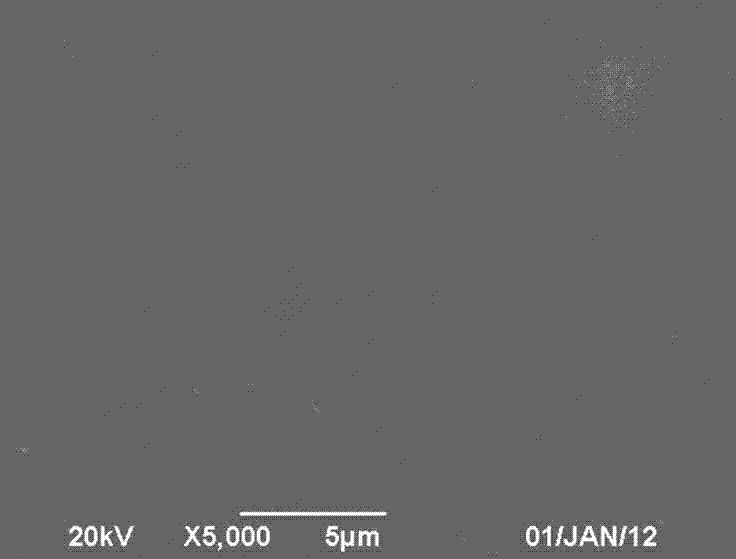Method for separating corncob cellulose by using ionic liquid
An ionic liquid and cellulose technology, which is applied in fiber raw material processing, textiles and papermaking, etc., can solve problems such as separation process research that has not been seen before, and achieve the effect of smooth surface, good film-forming properties and dense structure.
- Summary
- Abstract
- Description
- Claims
- Application Information
AI Technical Summary
Problems solved by technology
Method used
Image
Examples
Embodiment 1
[0027] (1) Raw material handling
[0028] The corn cob raw material is recovered, dried in the sun to make the moisture content less than 6%; crushed by a high-speed multifunctional grinder for 5 minutes to 30 minutes, every crushed for 2 minutes, with an interval of 1 minute; the crushed material is passed through a 40 mesh to 60 mesh sieve; soaked in distilled water for 1.5 minutes h, filter and dry to obtain corn cob particles;
[0029] (2) Lignin removal
[0030] The 40-60-mesh corn cob raw material obtained by crushing was mixed evenly with 2% NaOH solution to form a mixed solution with a mass volume ratio of 1:20, and it was dissolved at 115 °C for 90 min. After the treatment is completed, filter, wash the filter residue with distilled water for 3 times, and fully vacuum-dry at 80°C to obtain corn cob palm cellulose;
[0031] (3) Cellulose dissolution
[0032] The ionic liquid was vacuum-dried at 90°C for 24 h; the corncob palm cellulose was mixed with the ionic liqui...
Embodiment 2
[0037] (1) Raw material handling
[0038] The corn cob raw material is recovered, dried in the sun to make the moisture content less than 6%; crushed by a high-speed multifunctional grinder for 5 minutes to 30 minutes, every crushed for 2 minutes, with an interval of 1 minute; the crushed material is passed through a 40 mesh to 60 mesh sieve; soaked in distilled water for 1.5 minutes h, filter and dry to obtain corn cob particles;
[0039] (2) Lignin removal
[0040] The crushed 40-60-mesh corncob raw material was mixed evenly with 1.5% NaOH solution to form a mixed solution with a mass-volume ratio of 1:20, and dissolved at 125°C for 90 min. After the treatment is completed, filter, wash the filter residue with distilled water for 3 times, and fully vacuum-dry at 80°C to obtain corn cob palm cellulose;
[0041] (3) Cellulose dissolution
[0042] The ionic liquid was vacuum-dried at 90°C for 24 hours; the corncob palm cellulose was mixed with the ionic liquid evenly to form...
Embodiment 3
[0047] The separation method of corn cob cellulose comprises the steps:
[0048] (1) Raw material processing
[0049] The corn cob raw material is recovered, dried in the sun to make the moisture content less than 6%; crushed by a high-speed multifunctional grinder for 5 minutes to 30 minutes, every crushed for 2 minutes, with an interval of 1 minute; the crushed material is passed through a 40 mesh to 60 mesh sieve; soaked in distilled water for 1.5 minutes h, filter and dry to obtain corn cob particles;
[0050] (2) Lignin removal
[0051] The crushed 40-60-mesh corncob raw material was mixed evenly with 2% NaOH solution to form a mixed solution with a mass volume ratio of 1:20, and was dissolved at 110°C for 90 min. After the treatment is completed, filter, wash the filter residue with water for 3 times, and fully vacuum-dry at 80°C to obtain corncob palm cellulose;
[0052] (3) Cellulose dissolution
[0053] The ionic liquid was vacuum-dried at 90°C for 24 hours; the c...
PUM
 Login to View More
Login to View More Abstract
Description
Claims
Application Information
 Login to View More
Login to View More - R&D
- Intellectual Property
- Life Sciences
- Materials
- Tech Scout
- Unparalleled Data Quality
- Higher Quality Content
- 60% Fewer Hallucinations
Browse by: Latest US Patents, China's latest patents, Technical Efficacy Thesaurus, Application Domain, Technology Topic, Popular Technical Reports.
© 2025 PatSnap. All rights reserved.Legal|Privacy policy|Modern Slavery Act Transparency Statement|Sitemap|About US| Contact US: help@patsnap.com



